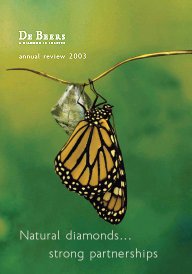De Beers Annual Review: What a Ride
April 01, 04
Under the title “Partnerships are key to our growth”, the De Beers Group released its 2003 annual review.
“It connects us to all aspects of our business and continues to play a key role in our growth and sustainability. It is for this reason that we have woven this theme into our new annual review,” the company says.
|
|
Partnership is not just a recurring theme, it also seems to be the main message from the company that enjoyed a fantastic year financially but took a beating on almost every other front. Chairman Nicky Oppenheimer called it a watershed year.
The company achieved record sales of $5.5 billion, enabling it to increase earnings before debt redemption by 17 percent to $465 million and headline earnings by 18 percent to $676 million. The cash flow it generated enabled it to replace its five-year $3.5 billion loan with a $2.5 billion revolving credit facility.
But while it justly prides itself on its support for South African conservation projects, the battle against HIV/AIDS and deep pocket contributions to other social responsibility causes, the rolling out of the Supplier of Choice program and new Sightholder list caused a surprising uproar in the diamond centers.
The outcome was court cases in Antwerp, renewed scrutiny by the EC and, related or not, no decision on the Alrosa agreement that resulted in reduced supply from the Russian miner.
And while in Africa some voices were heard about price re-examination, in Canada it looks like the company is meeting resistance from local authorities who are moving the approval process of Snap Lake forward at snail pace, depriving the company from mining in the third biggest production source.
Needless to mention, the weaker dollar hurt mining operations, pushing up costs in countries such as Botswana and South Africa during a year of record production.
On the retail front, the De Beers LV venture is yet to capture the kind of public attention and fervor that is so essential for a luxury brand.
A recent report by WWW International Diamond Consultants says De Beers' market share has dropped to under 50 percent, well below the last figure of 60 percent.
There is no need to feel sorry for De Beers, however. The company is alive, very profitable and, under the leadership of Gary Ralfe and heir-apparent Gareth Penny, re-adjusted itself to a new era that includes restructuring, new management faces and a great return on investment for the shareholders who boldly took the company back into private hands.
“With 20 mines currently in production in Africa and with expertise in every form of mining built up over more than a century, De Beers has the skills to surmount the formidable technical challenges that face us wherever we operate, from deep sea to alluvial and open pit to underground,” the company says.
That statement is probably right, and yet it still took a public beating.
At this point of time, three months into 2004, it looks like the Group will have an even better year. Clearing away legal issues in the US will allow it to enter the world’s largest market in full force and improved economic conditions in Japan will allow even greater sales in the second biggest market.
Last year DTC spent $180 million on marketing and initiatives partially inspired by SoC have propelled an estimated $272 million investment in marketing by others in the industry. DTC clients alone, the company says, developed some 250 marketing initiatives. This drives increased sales both in terms of the number of items sold as well as in the average expenditure per item.
“As we continue to transform ourselves to retain our leadership in the diamond industry, we believe it is equally vital that we remain committed to the fundamentals that made us a leader more than a century ago.”
With its leadership role safe, the influence De Beers has had on the entire pipeline in the past few years will no doubt continue in the near future.
